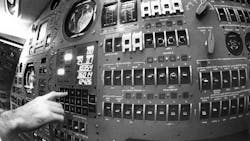The Apollo navigation computer began with a small, rudimentary general-purpose space probe processor
CAMBRIDGE, Mass. – In the late 1950’s, before NASA had any intentions of going to the Moon – or needing a computer to get there — the MIT Instrumentation Laboratory had designed and built a small prototype probe they hoped would one day fly to Mars. Universe Today reports. Continue reading original article
The Military & Aerospace Electronics take:
8 Oct. 2019 -- This little probe used a small, rudimentary general-purpose computer for navigation, based on the inertial systems for ballistic missiles, submarines, and aircraft the Lab had designed and built for the military since World War II.
The folks at the Instrumentation Lab thought their Mars Probe concept — and in particular the navigation system — would be of interest to the those involved in the fledgling planetary exploration efforts, such as the US Air Force and the Jet Propulsion Laboratory.
But when the MIT Lab approached them, neither entity was interested. The Air Force was getting out of the space business, and JPL had plans to operate their own planetary spacecraft, doing navigation from the large Goldstone communication dish in the Mojave Desert. The 26-meter radar dish had been constructed for tracking the early robotic Pioneer probes.
Related: There's never been a better time to be in the space electronics market
John Keller, chief editor
Military & Aerospace Electronics
